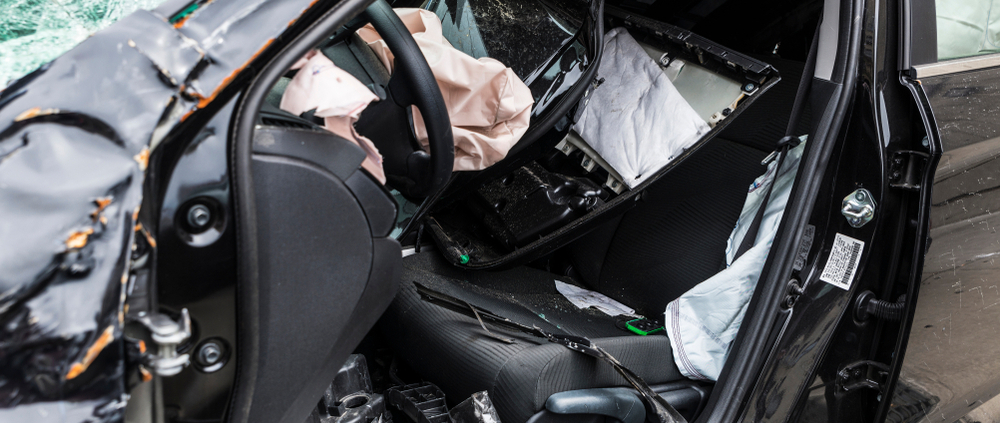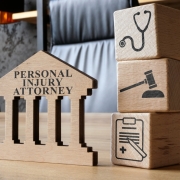Personal Injury & Medical Malpractice Lawsuits in New York: An In-Depth Analysis
By Brian Figeroux, Esq. | Editorial credit: J2R/ shutterstock.com
Personal injury lawsuits related to slip-and-fall accidents, car crashes, and medical malpractice claims continue to dominate New York courts. Despite the challenges, individuals injured due to someone else’s negligence have the right to seek compensation for their medical expenses, lost wages, and pain and suffering. By understanding the legal framework surrounding these claims and working with experienced attorneys, plaintiffs can navigate the complexities of personal injury law and pursue justice for the harm they have suffered. Read more at www.askthelawyer.us. To read the complete analysis on our personal injury blog, click here.
Personal injury lawsuits, particularly those involving slip-and-fall accidents, car crashes, and medical malpractice claims, dominate the legal landscape in New York State (NYS). These cases often arise when individuals seek compensation for injuries resulting from another party’s negligence. In the state’s courts, personal injury lawsuits serve as a crucial mechanism for holding individuals, businesses, and professionals accountable for the harm they cause.
In New York, both slip-and-fall cases and automobile accidents generate a significant number of personal injury claims. Additionally, medical malpractice, particularly involving misdiagnosis and surgical errors, is another frequent area of litigation. This analysis explores the legal framework surrounding these personal injury lawsuits, the common issues involved, and the steps plaintiffs take to pursue compensation.
- Slip-and-Fall Accidents in New York
1.1 Legal Foundation for Slip-and-Fall Claims
Slip-and-fall accidents are among the most common personal injury lawsuits in New York. These claims typically fall under the broader category of premises liability law, which holds property owners responsible for maintaining safe environments for visitors. Under New York law, property owners must exercise “reasonable care” to ensure that their premises are safe for guests, tenants, or customers. Failure to do so may result in liability if a person is injured on the property.
In a slip-and-fall case, the plaintiff must demonstrate that the property owner or manager was negligent in maintaining the premises. This involves proving that:
- A dangerous condition (such as a wet floor, uneven pavement, or poorly lit staircase) existed.
- The owner knew or should have known about the condition.
- The owner failed to address the hazard within a reasonable time, causing the injury.
1.2 Common Challenges in Slip-and-Fall Cases
Slip-and-fall cases are not always straightforward. One of the primary challenges plaintiffs face is proving that the property owner was aware of the hazardous condition. In many cases, defendants argue that the condition was temporary or that the injured party should have been aware of the risk. To overcome these challenges, plaintiffs often rely on surveillance footage, maintenance records, or eyewitness testimony to demonstrate that the dangerous condition was either long-standing or negligently addressed.
For example, a plaintiff who slips on ice outside a store may need to prove that the store owner failed to salt or shovel the area within a reasonable time after a snowstorm. Additionally, comparative negligence may come into play, where the defendant argues that the injured person was partially at fault (e.g., by not paying attention or ignoring warning signs).
1.3 Damages in Slip-and-Fall Cases
Plaintiffs in slip-and-fall cases can seek various forms of compensation, including:
- Medical expenses (past and future)
- Lost wages (if the injury affects the plaintiff’s ability to work)
- Pain and suffering (both physical and emotional)
- Punitive damages (in cases of gross negligence or willful misconduct)
These damages are intended to restore the plaintiff to the condition they were in prior to the accident, to the extent that money can achieve that goal.
- Car Accidents and Personal Injury Claims
2.1 New York’s No-Fault Insurance System
New York operates under a no-fault insurance system, meaning that individuals injured in car accidents must first file claims with their own insurance company, regardless of who was at fault for the accident. This system is designed to provide quick compensation for medical expenses and lost wages without the need for litigation. However, the no-fault system does not cover non-economic damages, such as pain and suffering. To pursue such damages, the injured party must meet the threshold for a “serious injury” as defined by New York law.
Under New York Insurance Law, a serious injury includes:
- Fractures
- Significant disfigurement
- Permanent loss of use of a body organ or system
- Death
- Injuries that result in significant limitations to normal bodily functions or a substantial impairment for at least 90 days.
If the injury qualifies as “serious,” the injured party can file a personal injury lawsuit against the at-fault driver to seek compensation for pain and suffering and other non-economic damages.
2.2 Liability in Car Accidents
Proving liability in car accident cases often hinges on demonstrating negligence. To establish negligence, the plaintiff must show that:
- The defendant had a duty of care (e.g., obeying traffic laws and driving safely).
- The defendant breached that duty (e.g., by speeding, running a red light, or driving while distracted).
- The breach caused the plaintiff’s injuries.
- The plaintiff suffered damages as a result.
In many car accident cases, fault is relatively clear, such as when one driver rear-ends another. However, other cases may involve disputes over shared liability, where both parties may bear some responsibility for the accident. In such cases, New York’s comparative negligence rule applies, meaning that the plaintiff’s compensation may be reduced in proportion to their level of fault.
2.3 Damages in Car Accident Cases
In car accident lawsuits, plaintiffs can recover various types of damages, including:
- Medical expenses
- Property damage (e.g., vehicle repair or replacement costs)
- Lost wages
- Pain and suffering
- Emotional distress
In particularly severe cases, plaintiffs may also seek punitive damages if the defendant’s conduct was especially reckless, such as in cases of drunk driving.
- Medical Malpractice Lawsuits: Misdiagnosis and Surgical Errors
Medical malpractice claims are a distinct category of personal injury lawsuits and often involve complex issues of medical standards of care. These lawsuits are typically filed when a patient suffers harm due to a healthcare provider’s negligence, particularly in cases of misdiagnosis or surgical errors.
3.1 Elements of a Medical Malpractice Claim
To succeed in a medical malpractice claim, the plaintiff must prove four key elements:
- Duty of Care: The healthcare provider owed the patient a duty to provide competent medical care.
- Breach of Duty: The provider breached this duty by failing to meet the accepted standard of care in the medical community.
- Causation: The breach directly caused the patient’s injury.
- Damages: The patient suffered harm as a result, such as physical injury, increased medical bills, or prolonged illness.
3.2 Misdiagnosis Cases
Misdiagnosis is one of the most common types of medical malpractice claims. A misdiagnosis occurs when a healthcare provider fails to identify a patient’s condition accurately, leading to incorrect treatment or delayed care. In New York, misdiagnosis claims often involve serious conditions such as cancer, heart disease, or infections, where early detection is critical to effective treatment.
For example, if a doctor fails to diagnose cancer in its early stages due to inadequate testing or misinterpretation of lab results, the patient may lose the opportunity for life-saving treatment. In such cases, the patient can file a medical malpractice lawsuit, claiming that the delayed diagnosis caused their condition to worsen.
3.3 Surgical Errors
Surgical errors are another frequent basis for medical malpractice claims. These errors may include operating on the wrong body part, leaving surgical instruments inside the patient, or making critical mistakes during surgery that result in complications or death.
In New York, proving negligence in surgical error cases requires demonstrating that the surgeon or surgical team failed to meet the standard of care expected during the procedure. Expert testimony is often necessary to establish whether the healthcare provider’s actions fell below this standard.
3.4 Damages in Medical Malpractice Cases
Patients who file medical malpractice lawsuits may recover various types of compensation, including:
- Medical costs for correcting the error or managing the complications.
- Lost wages due to the inability to work while recovering from the injury.
- Pain and suffering associated with the physical and emotional toll of the injury.
- Loss of enjoyment of life if the injury results in long-term disability or chronic pain.
- Steps to File a Personal Injury Lawsuit in New York
Filing a personal injury lawsuit in New York involves several critical steps:
4.1 Consulting an Attorney
The first step is to consult with an experienced personal injury attorney. New York’s personal injury laws are complex, and a lawyer can help navigate the legal process, gather evidence, and determine the appropriate course of action.
4.2 Filing a Complaint
The plaintiff’s attorney will file a complaint in the appropriate New York court, outlining the legal claims, the facts of the case, and the damages being sought. This document is then served on the defendant, who has the opportunity to respond.
4.3 Discovery and Negotiation
Both parties engage in discovery, a process of exchanging evidence and information related to the case. Often, cases are resolved through settlement negotiations, where the defendant agrees to compensate the plaintiff without going to trial.
4.4 Trial
If a settlement cannot be reached, the case may proceed to trial. The plaintiff must present evidence to prove their caseor judgment, where a judge or jury will determine whether the defendant was liable and, if so, the amount of damages the plaintiff is entitled to receive. Most personal injury cases, however, are resolved before trial through settlements, with both sides avoiding the uncertainty and costs associated with a court verdict.
- The Role of Comparative Negligence in New York Personal Injury Lawsuits
In New York, personal injury cases are subject to the state’s comparative negligence rule, which allows plaintiffs to recover damages even if they are partially responsible for their injuries. Under this system, the court will assign a percentage of fault to both the plaintiff and the defendant. The plaintiff’s total award will then be reduced by their percentage of fault.
For example, if a plaintiff in a car accident lawsuit is found to be 20% at fault for the accident (e.g., by not wearing a seatbelt or speeding), and the court awards them $100,000, their compensation will be reduced to $80,000 to account for their share of the blame.
This rule applies to all personal injury cases in New York, including slip-and-fall accidents, car crashes, and medical malpractice claims.
- Statute of Limitations for Personal Injury Claims in New York
Another important factor in New York personal injury lawsuits is the statute of limitations, which sets a time limit for filing a claim. In general, plaintiffs must file a personal injury lawsuit within three years of the date of the injury. For medical malpractice claims, the statute of limitations is typically two and a half years from the date of the malpractice or from the end of continuous treatment by the defendant for the condition.
There are exceptions to these time limits, such as cases involving minors or situations where the injury was not discovered until later (the “discovery rule”). It is crucial for plaintiffs to be aware of these deadlines and consult an attorney promptly to ensure their right to pursue a claim is preserved.
Conclusion
Personal injury lawsuits related to slip-and-fall accidents, car crashes, and medical malpractice claims continue to dominate New York courts. These cases often involve complex legal issues, including proving negligence, determining damages, and navigating the no-fault insurance system in car accident cases. In medical malpractice claims, plaintiffs face the additional challenge of proving that a healthcare provider’s actions fell below the accepted standard of care.
Despite the challenges, individuals injured due to someone else’s negligence have the right to seek compensation for their medical expenses, lost wages, and pain and suffering. By understanding the legal framework surrounding these claims and working with experienced attorneys, plaintiffs can navigate the complexities of personal injury law and pursue justice for the harm they have suffered.












Leave a Reply
Want to join the discussion?Feel free to contribute!